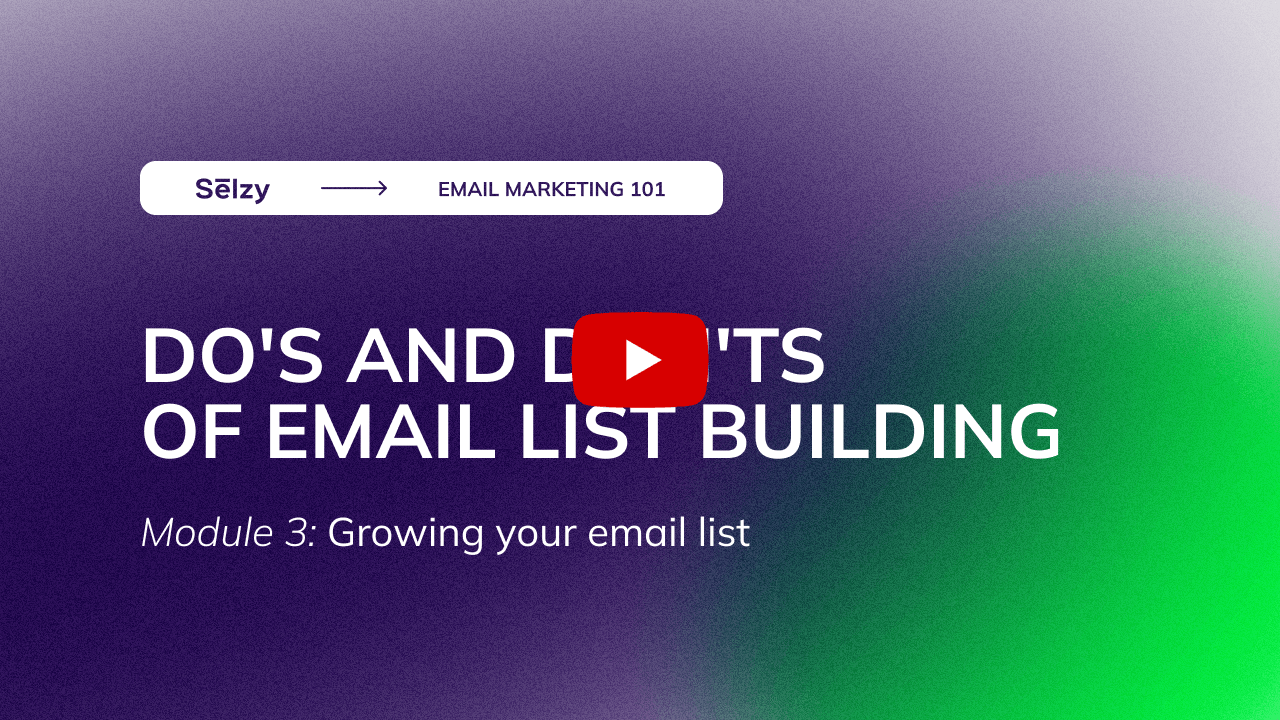Do’s and don'ts of email list building
This is a transcript of lesson 5 of Email Marketing 101 Course by Selzy.

Welcome to Module 3. This module is all about growing your email list. In lesson 1, we’ll talk about all the do’s and don’ts of email list building.
What’s the most important thing about your list?
You need a list of contacts to start sending email campaigns. Guess what’s the most important thing about your list?
The size — the more the better? Nope. It’s the quality of each subscriber. What you want from your list is sales, not a vast contact base of uninterested folks.
Imagine a list that has 10 000 contacts but brings only 20 sales. And now, imagine a list that has 1000 contacts – and it brings 100 sales. Which one would you choose?

This visual is only available in a video lesson
Only quality lists full of active subscribers, interested in your brand, can drive conversions. Make building such a list your goal when you are creating forms or marketing strategies instead of clickbait signup forms or aggressive list acquisition periods.
Now, the crucial step toward a quality list is consent. Email marketing is a perfect marriage where people must give their permission so you could send them emails. If it’s not mutual, it’s not gonna work. Even worse: emailing without consent is illegal. No consent — no sending.

This visual is only available in a video lesson
Responsible marketers respect this basic principle: they care about their business and reputation and, well, they don’t want to pay hefty fines for breaking the law.
The dark side of email marketing is spammers, hustlers who want to make quick bucks and who don’t care about growing their business, or their sender reputation. They probably think “why bother when there are ways to beat the snail-paced marketers”? Fortunately, their “quick” methods make no sense, and here’s why:

This visual is only available in a video lesson
Don'ts of email list building
Let’s talk about what you should NOT do when you start building your email list.
Don’t number 1: Don’t buy a list
Buying an email list may seem like an easy start but in fact, it’s a huge waste. It won’t pay off for a few reasons:
People have no reason to open these emails or buy. They didn’t show any interest in your brand; in fact, no one asked them if they wanted to hear about random things from a complete stranger. Even if a subscriber on a bought list shows interest, this happens by luck. But higher chances are that the spammer gets blacklisted before it happens.

This visual is only available in a video lesson
People get annoyed — and annoyed recipients just mark emails as spam. Too many spam complaints and the sender is banned from launching any future campaigns and can also be sued.

This visual is only available in a video lesson
Bought lists are hotbeds for spam traps. Spam traps are fake addresses used to catch spammers. One spam trap is enough to get you banned from sending any more emails. For better or worse, there’s no way to identify spam traps. They are an actual inbox that can receive and their spam filters may even engage with your email. The only issue is there is no human on the other side. This means that there is no way they could have subscribed to your email. The word trap is in the name!

This visual is only available in a video lesson
Don’t number 2: Don’t get emails from open sources
Getting email addresses from open sources like websites, forums and social media is no better than buying a contact list. It will result in the same issues.
It’s unlikely that someone thinks “hmm I leave my email here because I want to receive spam from random people in the future”. This is perhaps only possible in an alternate universe where stock photos of happy office workers are real.

This visual is only available in a video lesson
Don’t number 3: Don’t add contacts from your inbox
Sitting next to someone in a movie theater doesn’t mean you can sip on their Coca-Cola. It’s the same with emails.
Don’t number 4: Don’t download free lists
Spammers give away lists that no longer make them money. The thing is, these are inactive, dead contacts. You have more chances to correctly guess a random number from 1 to 1,000,000 than to sell anything with a free list before it affects your overall inboxing which renders your emails useless from a marketing standpoint.
Don’t number 5: Don’t parse email addresses
Special programs called parsers scan a web page — for example, a culinary forum — and download the email addresses people use to sign in. Parsing is almost identical to getting emails from open sources, only arguably worse from a moral perspective.
Don’t number 6: Don’t autogenerate a list
Meaning using a program automatically generates addresses and builds up a base. Let’s play this game — is your email address [email protected]? Nope? Well, you’ve just seen how effective autogeneration is.
That’s it, here are the six don’ts of email list building. Trying to sell by those means is like buying a $10 Swiss watch from AliExpress and seeing it show the right time only twice a day — it’s just not gonna work.

This visual is only available in a video lesson
Do’s of email list building
Now let’s see how you can get a quality email list with willing customers that give their consent.
Do number 1: Use online subscription forms
Sign-up forms are the main way to get new contacts. When users leave their email addresses on a webpage, they give their consent to want to receive emails from a brand. Here’s one of Selzy’s pop-up forms. As you can see here, it explains clearly what people are signing up to and what Selzy will do with this information. This is the best way to ensure there are quality subscribers on your lists.

This visual is only available in a video lesson
Do number 2: Get emails when customers sign up or buy
If you ask people to register to use your product — for example, to leave comments under articles or make purchases — you can use these emails for sales purposes. Don’t forget to ask people if they wish to receive emails from you, with a caption or a checkbox with a clear statement.

This visual is only available in a video lesson
Do number 3: Get emails offline
People leave their emails when they attend an event (say, a conference) or a physical store. The advantage of this method is that potential customers already made a big effort to get to know you, so the emails they’ll leave will be very high-quality contacts. You can also use that information to better target the types of content they would like to receive emails about.
Do number 4: Enlarge your base through social media
Your subscribers on Facebook may be happy to give you their emails, especially if they’re already fans of your product, or in exchange for a very special top-secret deal 😉

This visual is only available in a video lesson
Do number 5: Use lead magnets as a boost
Lead magnets are things you give for free in exchange for an email address. For example, a discount, a free pdf guide or a product sample. For example, at Selzy, we offer a free guide to email list building in exchange for your email and consent to receive our newsletter.
By itself, a lead magnet isn’t a way to build a list but it’s a good boost to get subscribers hooked.

This visual is only available in a video lesson
Do number 6: Use double-opt-in
When people give their consent, they may have an option to confirm their subscription. This is called a double opt-in. A special email with a confirmation link comes to a potential subscriber, like this one that you get after signing up with Selzy. If he or she clicks it, a subscription is confirmed and you have a new subscriber.

This visual is only available in a video lesson
Double opt-in generates more value over time, keeps your email list clean, provides you with more accurate subscriber data, enhances your sender reputation, lowers the unsubscribe rate, improves deliverability (which means how many emails arrive in people’s inboxes instead of landing in spam), and makes it less likely for you to be reported as a spammer.
Don’t forget, that bad deliverability doesn’t only affect your relationship with subscribers that don’t care about your emails, but can also affect your inboxing with subscribers who are looking for your emails and want to engage with them.
The alternative to double opt-in is a single opt-in: people leave their email, click “Subscribe” and join your list. But since there’s no extra confirmation, misspelled or fake addresses make their way into a list and you send emails to non-existent customers. It wastes your money because you pay for subscribers and, even worse, such emails may turn into spam traps. Also, you would be surprised at the amount of bots out there that just randomly adds emails to unprotected forms. More than you’d imagine!
Do you want rapid growth? A single opt-in may be the solution. But if you aim for interested subscribers to sell your products to, choose a double opt-in.
In the next few videos we’ll zoom in on the right ways to build an email list so you can have your first contact base. Stay tuned:)
This is a transcript of lesson 5 of Email Marketing 101 Course by Selzy.